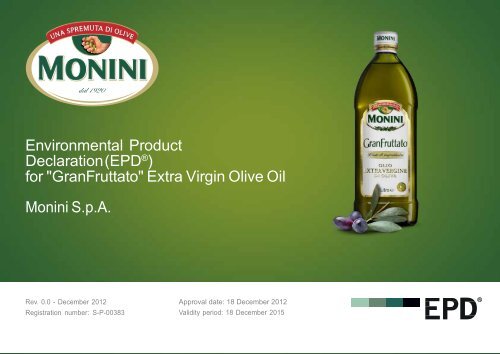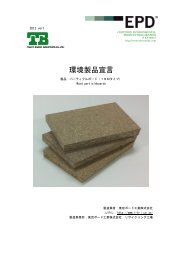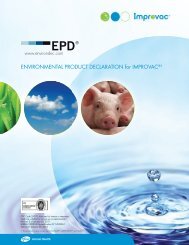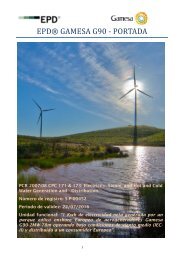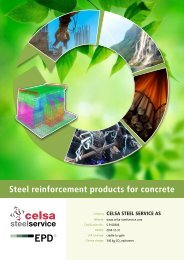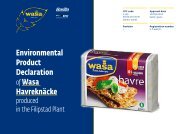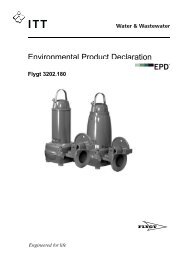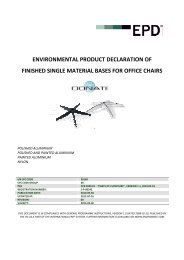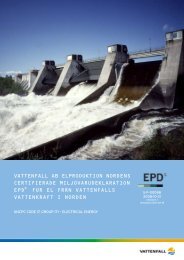(EPD®) for "GranFruttato" - Monini
(EPD®) for "GranFruttato" - Monini
(EPD®) for "GranFruttato" - Monini
- No tags were found...
Create successful ePaper yourself
Turn your PDF publications into a flip-book with our unique Google optimized e-Paper software.
Environmental ProductDeclaration (EPD ® )<strong>for</strong> "GranFruttato" Extra Virgin Olive Oil<strong>Monini</strong> S.p.A.Rev. 0.0 - December 2012Registration number: S-P-00383Approval date: 18 December 2012 ®Validity period: 18 December 2015
The All-Italian Story<strong>Monini</strong> EPD01 ® , December 2012of a Passionp. 2MONINI,THE ALL-ITALIAN STORYOF A PASSIONA passion <strong>for</strong> qualitythat dates back over a centuryThe <strong>Monini</strong> company is an Italian successstory based on tradition and quality. Thecompany was founded in 1920 by Zefferino<strong>Monini</strong>, who, following his entrepreneurialinstinct, decided to establish a business inthe town of Spoleto, in the Italian region ofUmbria. Thanks to its hills covered with olivegroves, from which an oil with an intense yetbalanced flavour is obtained, the Spoletoarea has always been dedicated tothe production of Extra Virgin Olive Oil.The passion that Zefferino <strong>Monini</strong> Sr.developed <strong>for</strong> olives at an early age led himto dedicate himself to the production of ExtraVirgin Olive Oil, whereby he founded thecompany "Zefferino <strong>Monini</strong> Olio di Oliva" in1930. The knowledge and consumption ofExtra Virgin Olive Oil at the time was limited,and was locally confined exclusively to itsareas of production. Most Italians, above allin the larger cities, either out of habit or lackof knowledge, used almost exclusively regularolive oil, rather than the extra virgin variety.By deciding to market Extra Virgin Olive Oilbeyond the confines of the Umbria region,Zefferino <strong>Monini</strong> launched a new trend inthe oil industry. Thanks to his initiative andhis passion <strong>for</strong> the natural product of hishomeland, together with the exceptionalquality of the oil obtained from the hills ofUmbria, Zefferino <strong>Monini</strong> succeeded in writingthe first page in the history of the ExtraVirgin Olive Oil market. Once brought to theattention of a wider audience, <strong>Monini</strong> extravirgin olive oil became increasingly popularand began to be demanded by customerseven further afield. The company ceasedoperations during the war as the product wassubject to rationing. Once the distribution offoodstuffs was deregulated in 1945, however,the company's operations continued withrenewed energy. It was at this time thatZefferino's sons, Giuseppe and Paolo, joinedthe company. Giuseppe and Nello flankedtheir father in his traditional laboratory,learning the all the tricks of the trade.At the time, shopkeepers sold the productin bulk. Anticipating the future needs of themarket, however, the first glass bottles beganflanking the traditional demijohns by the year1950.
The All-Italian Story<strong>Monini</strong> EPD01 ® , December 2012of a Passionp. 3A historic oil in modern times.Today, <strong>Monini</strong> is one of the leadingcompanies in the Extra Virgin Oil industry,boasting over 100 employees and a turnoverof nearly 125 million Euros in 2011. 90%of the total turnover is generated underthe <strong>Monini</strong> brand name. The strategythat Zefferino Sr. began in the 1920s wasstrengthened and enhanced by his son,Giuseppe, and is still being carried <strong>for</strong>wardby his grandchildren, Zefferino Jr. and MariaFlora. To this day, the family continues todiffuse the culture of Extra Virgin Olive Oil, notonly in terms of sales an distribution, but interms of education and awareness as well.The <strong>Monini</strong> family has been producing ExtraVirgin Olive Oil <strong>for</strong> three generations, usingexclusively mills whose hygiene conditions,processing systems and storage conditionssatisfy the company's stringent qualityrequirements. A company that's on thecutting-edge in terms of facilities, technologyand quality control, continuously driven bya passion <strong>for</strong> tradition, offering consumersa product of unrivalled quality. Like hisgrandfather be<strong>for</strong>e him, Zefferino <strong>Monini</strong> stillpersonally samples the company's productsto this day, selecting only the productsthat fully satisfy the company's high qualitystandards.
The <strong>Monini</strong><strong>Monini</strong> EPD02 ® , December 2012Groupp. 4THE MONINI GROUPNORTH AMERICA,POLAND AND AUSTRALIAA company that symbolizesthe Italian Olive Oil TraditionThis propensity to diffuse the culture ofExtra Virgin Olive Oil and to safeguard theart of Italian olive oil production as a symbolof Made in Italy quality, has rendered thisUmbrian company a reference point <strong>for</strong> theentire industry, even beyond the confines ofItaly itself.<strong>Monini</strong> North America Inc., with headquartersin Norwalk Connecticut, was founded in theyear 2000, and currently boasts an annualturnover of nearly 6 million U.S. dollars.The brand's presence throughout Europeis guaranteed by its subsidiary, <strong>Monini</strong>Polska, which was founded in 2008, withheadquarters in Poznan, Poland.In 2001, <strong>Monini</strong> also began heavily investingin modern olive-cultivation in the Australianstate of New South Wales, purchasing nearly700 hectares of land in a joint venture projectwith an Italian family that has been living inAustralia <strong>for</strong> over 50 years. A cutting-edgeproject with a unique plantation, not only interms of the type of crop cultivated, but alsoin terms of the methods used to cultivate andharvest the olives themselves. The plantationis home to over 106,000 trees of theFrantoio, Leccino, Pendolino and Coratinavarieties, which were planted in 2004 andhave literally flourished under the Australiansun.
The Company <strong>Monini</strong> EPD03 ® , December 2012p. 5THE COMPANYEnvironmental PolicyPackagingplantToday, <strong>Monini</strong> is a company that's on thecutting-edge in terms of facilities, technologyand quality control, upholding the Italian oliveoil tradition thanks to a responsible corporatemanagement model based on environmentalsustainability, business ethics and socialawareness. As evidenced by variousinterventions, <strong>Monini</strong> has recently undertakena major "eco-sustainability" project, includingthe installation of a photovoltaic system atthe production facility, the provision of energyfrom certified renewable sources, and the useof eco-friendly recycled glass packaging.Thanks to this policy, <strong>Monini</strong> has becomethe first large Italian company to obtain anEnvironmental Product Declaration (EPD ® ).<strong>Monini</strong>'s environmental policy is based on asimple philosophy: to never deprive nature orthe terrain of anything. Because it is preciselynature and the terrain that have provided thisSpoleto-based company with its preciousraw materials, allowing it to make a name<strong>for</strong> itself over the past 100 years. <strong>Monini</strong>has assumed this exemplary commitmentto the environment and its natural fruits inorder to ensure that they are preserved <strong>for</strong>generations to come. It's the best possibleinvestment that the company could make inorder to preserve the values underlying the<strong>Monini</strong> olive oil tradition over time.The <strong>Monini</strong> S.p.A. production facility islocated in Spoleto (Italy), at Km 129 SSFlaminia.<strong>Monini</strong> S.p.A. produces more than30,000,000 litres of oil per year, approximately80% of which is Extra Virgin Olive Oil. 30% ofthe 2011 turnover was generated by exportsto over 30 countries. The company occupiesa total surface area of 22,000 square meters,10,000 of which are indoors, boasting sevenpackaging lines with a maximum productioncapacity of 15,000 litres/hour in various<strong>for</strong>mats, as well as a raw material filtrationline.
The Company <strong>Monini</strong> EPD03 ® , December 2012p. 6Supply chain controlOils made from olives of different varieties,origins and maturity, and stored underdifferent conditions and <strong>for</strong> differenttime frames, naturally possess differentcharacteristics. For this reason, Zefferino<strong>Monini</strong> Jr., together with some of his closestexpert collaborators, select the best oilsin a special tasting room on a daily basis,recording the intensity and the differentflavour and olfactory characteristics of eachoil sampled. Approximately 15,000 oil tastingsessions are held each year during theselection and receipt of the raw materials,as well as be<strong>for</strong>e packaging. These controlactivities are not only limited to the rawmaterials themselves, but the quality of thefinal product is also guaranteed by the loyalty,collaboration, and control activities per<strong>for</strong>medby the entire supply chain.Quality controlA state-of-the-art analytical laboratorymonitors the quality and purity of each oil.These highly complex analyses are usedto reveal the presence of any oils otherthan olive oil, as well as the presence ofany undesired substances contained withinthe oils themselves due to treatments withagrochemicals (pesticides, herbicides orfungicides) or simply due to environmentalpollution. Modern analytical techniques andsophisticated equipment allow <strong>for</strong>contaminants to be detected in tenths of partsper billion: this means that it is possible todetect the presence of even just one gram of acontaminant dissolved in 10,000 tonnes of oil !The <strong>Monini</strong> analysis laboratory per<strong>for</strong>msapproximately 20,000 sets of analysis peryear, controlling approximately 90,000parameters. Most of the controls areper<strong>for</strong>med upon the incoming product, thusallowing <strong>for</strong> non-compliant batches of oil tobe rejected, while further controls are alsocarried out during the packaging stage.Subsequently, the quality levels of the oilsdestined <strong>for</strong> the national and internationalmarkets are sampled and monitored.
Calculation of environmental<strong>Monini</strong> EPD04 ® , December 2012per<strong>for</strong>mancep. 7CALCULATIONOF ENVIRONMENTALPERFORMANCE<strong>Monini</strong> GranFruttato Extra Virgin Olive Oil 1-litre, 0.75 -litre and 0.5 -litre bottle.This EPD ® refers to the product ofGranFruttato Extra Virgin Olive OilOver the past three years, the company'sGranFruttato Extra Virgin Olive Oil hasgenerally been produced using olives grownin Italy.The GranFruttato Extra Virgin Olive Oil ispackaged in bottles of light coloured glass;the primary packaging consists of two paperlabels applied to the bottle (front and back),an aluminium cap and a plastic spout; thestandard secondary packaging consists of aPVC capsule (Polyvinyl chloride), a tray madeof cardboard and shrink-wrap film, while thetertiary packaging is comprised of a palletand transparent outer film.In this EPD ® , the density of the Extra VirginOlive Oil is considered equal to 0.916 kg/litre.Functional unitIn accordance with PCR 2010:07, thefunctional unit <strong>for</strong> the life cycle refers toone (1) litre of Extra Virgin OliveOil, including its packaging .
Calculation of environmental<strong>Monini</strong> EPD04 ® , December 2012per<strong>for</strong>mancep. 8GEOGRAPHICALORIGIN<strong>Monini</strong> GranFruttato Extra Virgin Olive OilItalyPuglia.
Calculation of environmental<strong>Monini</strong> EPD04 ® , December 2012per<strong>for</strong>mancep. 9CHARACTERISTICSOF THE EXTRA VIRGIN OLIVE OIL<strong>Monini</strong> GranFruttato Extra Virgin Olive OilThe GranFruttato variety is a medium-fruityExtra Virgin Olive Oil that's obtained fromthe finest olives, harvested just prior to peakmaturity.It can be used freely according to taste.Even just a few drops will enliven your finestdishes.In the KitchenStrictly <strong>for</strong> raw consumption, on bruschettas,salads, raw vegetables, sliced raw meatand fish, hot minestrone and vegetablesoups, as well as grilled meats andvegetablesNUTRITIONAL VALUESIn relation to various productionlots per 100 ml of productEnergyvalue824 kcal3389 kJMONOUNSATURATED fatsPOLYUNSATURATED69 g9 gProtein 0 g Cholesterol 0 mgCarbohydrates 0 g Dietary fibre 0 gFatof which SATURATED92 g14 gSodiumVitamin E0 g15 mg*(*)150% of the RDARecommended dailyallowance
Calculation of environmental<strong>Monini</strong> EPD04 ® , December 2012per<strong>for</strong>mancep. 10ORGANOLEPTICCHEMICAL AND PHYSICALCHARACTERISTICS<strong>Monini</strong> GranFruttato Extra Virgin Olive OilORGANOLEPTIC CHEMICALAND PHYSICALCHARACTERISTICSAverageValueLimit Value<strong>for</strong> <strong>Monini</strong>Legal limitvalueReferencestandardFree acidity (% of oleic acid) 0.25 ≤ 0.5 ≤ 0.8 (1-3)Number of Peroxides (meqO2/kg) 7.5 ≤ 11 (Dec-May) ≤ 20 (1-2-3)≤ 13 (Jun-Nov)U. V. Spectrophotometry K 232 1.80 ≤ 2 (Dec-May)≤ 2.15 (Jun-Nov)≤ 2.50 (1-3)K 270 0.110 ≤ 0.14 (Dec-May) ≤ 0.22 (1-2-3)≤ 0.15 (Jun-Nov)∆K -0.002 ≤ 0.005 ≤ 0.01 (1-2-3)
Calculation of environmental<strong>Monini</strong> EPD04 ® , December 2012per<strong>for</strong>mancep. 11ORGANOLEPTIC AND CHEMICAL-PHYSICAL CHARACTERISTICS/1FATTY ACIDCOMPOSITION (%)AverageValueLimit Value<strong>for</strong> <strong>Monini</strong>Legal limitvalueReferencestandardC14:0 Myristic acid 0.1 - ≤ 0.05 (1-2-3)C16:0 Palmitic acid 11.56 - 7.5-20 (2-3)C16:1 Palmitoleic acid 0.84 - 0.3-3.5 (2-3)C17:0 Heptadecanoic acid 0.005 - ≤ 0.3 (2-3)C17:1 Heptadecenoic acid 0.10 - ≤ 0.3 (2-3)C18:0 Stearic Acid 2.18 - 0.5-5.0 (2-3)C18:1 Oleic acid 76.02 - 55-83 (2-3)C18:2 Linoleic acid 7.70 ≤ 11.5 3.5-21 (2-3)C18:3 Linoleic acid 0.67 ≤ 0.8 ≤ 1.0 (1-3)C20:0 Arachidic acid 0.38 - ≤ 0.6 (1-2-3)C20:1 Eicosenoic acid 0.26 - ≤ 0.4 (1-2-3)C22:0 Behenic acid 0.11 - ≤ 0.2 (1-2-3)C22:1 Erucic acid N.V. - 0.0 (1-2-3)C24:0 Lignoceric acid 0.05 - ≤ 0.2 (1-2-3)
Calculation of environmental<strong>Monini</strong> EPD04 ® , December 2012per<strong>for</strong>mancep. 12ORGANOLEPTIC AND CHEMICAL-PHYSICAL CHARACTERISTICS/2COMPOSITION IN TRANS FATTYACIDS ( %)AverageValueLimit Value<strong>for</strong> <strong>Monini</strong>Legal limitvalueReferencestandardC18: 1T (elaidinic acid) 0.01 ≤ 0.03 ≤ 0.05 (1-2-3)C18:2t+ C18:3t 0.01 - ≤ 0.05 (1-2-3)Total sterols (mg/kg) 1250 - ≥1000 (1-2-3)TRIGLYCERIDESHPLCAverageValueLimit Value<strong>for</strong> <strong>Monini</strong>Legal limitvalueReferencestandardTrilinoein (%) 0.07 ≤ 0.3∆ECN42 -0.09 - ≤ 0.2 (1-2-3)Stigmastadienes (mg/kg) 0.02 ≤ 0.06 ≤ 0.10 (1-2-3)Alkyl esters (mg/kg) 15 ≤ 40 ≤ 75 (1-3)
Calculation of environmental<strong>Monini</strong> EPD04 ® , December 2012per<strong>for</strong>mancep. 13ORGANOLEPTIC AND CHEMICAL-PHYSICAL CHARACTERISTICS/3TRIGLYCERIDESHRGCAverageValueLimit Value<strong>for</strong> <strong>Monini</strong>Legal limitvalueReferencestandard(1) Reg. CE 2568/91 and subsequentamendments, Reg. CE 1429/92 and Reg.CE 796/02, Reg. CE 1989/03 and lastly Reg.702/2007/CE, Reg. 61/20111.2 DiglyceridesWaxes (mg/kg)75.0 1 ≥ 70 (Dec-Mar)≥ 60 (Apr-Jul)≥ 50 (Aug-Nov)65 ≤ 150≤ 0.5≤ 250(4)(1-2-3)(2) Codex Alimentarius ALINORM 01/17; 17thsession of the codex committee on fats and oils.(3) International Olive Oil Council COI/T.15/NCno.3 rev. 1 of the 05/12/2003Halogenated solvents (mg/kg)0.03 -≤ 0.2(1-2-3)(4) Internal methodTotal polyphenols (mg/kg) 300 ≥ 150ORGANOLEPTIC EVALUATION(panel test)AverageValueLimit Value<strong>for</strong> <strong>Monini</strong>Legal limitvalueReferencestandardMedian defect 0 0 Md=0 (1-2-3)Median <strong>for</strong> "fruity" 5 4 Mf>0 (1-2-3)Panel Test 7.3 ≥ 6.5 6.5 Reg. 2568/91CEE
Calculation of environmental<strong>Monini</strong> EPD04 ® , December 2012per<strong>for</strong>mancep. 14ORGANOLEPTIC AND CHEMICAL-PHYSICAL CHARACTERISTICS/4MAIN RESIDUALCONTAMINANTSAverageValueLimit Value<strong>for</strong> <strong>Monini</strong>Legal limitvalueReferencestandardPAH: PolycyclicAromaticHydrocarbonsmg/tonB(a)P 0.0 < standard limitvaluesB(a)P 1.6 sum < standard limit 10B(a)A of the total valuesB(b)F of the 4 PAHCHR2Reg.1881/2006/EUandsub. Amend.Phthalates(mg/kg)2.66 totalsum of 8phthalatesexamined3.0 (DEHP)5.0 (<strong>for</strong>every otherindividualPhthalate)- -Agrochemicals(mg/kg)< standardlimitvalues< standardlimitvaluesThoseof the referencestandardsM.D. 27/08/2004andsub. Amend.
Calculation of environmental<strong>Monini</strong> EPD04 ® , December 2012per<strong>for</strong>mancep. 15BOUNDARIESOF THE SYSTEM/1Upstream, coreand downstream processesIn accordance with PCR 2010:07, the lifecycle of the Extra Virgin Olive Oil is dividedinto the Upstream, Core andDownstream phases.The Upstream phase includesthe following processes:• The operations required <strong>for</strong> theestablishment of the olive groves and thetrans<strong>for</strong>mation of the terrain's use were nottaken into consideration because the lifecycle of an olive grove is greater than 25years.• The production of the olives used later inthe Core process, involving the followingprocesses:- The production of the inputs utilized, suchas <strong>for</strong> example, fertilisers and agrochemicalproducts.- Waste management.The use of the wood resulting from pruningor from the end of the olive trees' life cycle.- The transportation of the inputs to theregion and to the olive production sites.- The auxiliary materials used to harvest theolives (nets, cages, detergents, etc.).- The production of the fuel and electricityused at the plantations.- The transportation of the olives to the mill.- The extraction and use of the water.
Calculation of environmental<strong>Monini</strong> EPD04 ® , December 2012per<strong>for</strong>mancep. 16BOUNDARIESOF THE SYSTEM/2Upstream, coreand downstream processesThe Core phase includesthe following processes:• The extraction of the oil from the olives.• Waste management.• The preservation of the oil.• Transportation to the packaging plant.• The packaging of the oil at the<strong>Monini</strong> facility in Spoleto.• The production of the packaging materials.The Downstream phase includesthe following processes:• Transportation from the final production/storage site to a distribution plat<strong>for</strong>m.• Transportation to the retailer.• Waste management.• The use of the product.• The recycling or disposalof the packaging/materials after use.• The transportation of the raw materials andenergy inputs to the Core process.
Calculation of environmental<strong>Monini</strong> EPD04 ® , December 2012per<strong>for</strong>mancep. 17BOUNDARIES OF THE SYSTEM/3Energy sources Chemicals Auxiliary Materials FuelsUPSTREAM CORE DOWNSTREAMCultivation and harvesting Crushing and Packaging Distribution and end of lifeMaterials in output:Olive Pomace
Calculation of environmental<strong>Monini</strong> EPD04 ® , December 2012per<strong>for</strong>mancep. 18DATA QUALITYThe inventory analysis was conducted usingspecific data from: <strong>Monini</strong> S.p.A. and fromthe companies involved in the study relatingto the cultivation and harvesting of the olives,oil extraction and preservation, transportationto the bottling plant and the packaging anddistribution of the product.Selected generic data was also used from:greenhouse gas emissions of the Italianenergy mix.Carbon Trust documents relating tothe percentage of oils and fats• not consumed and disposed of, fromOECD Compendiums <strong>for</strong> the amount ofglass recycled worldwide, from Eurostat<strong>for</strong> the amount of waste recycled anddisposed of.to data collection <strong>for</strong> the process unit oftrans<strong>for</strong>ming the harvested olives into oil(mill) and even less so <strong>for</strong> the process unitregarding the plantation involved in thecultivation of the olive trees. This situationhas been exacerbated by the economiccrisis, especially in Greece, where in facta number of <strong>Monini</strong>'s producers (includinghistorical) have gone out of business• The ECOIL project: Life CycleAssessment as a Decision Support Tool <strong>for</strong>the Eco Production of Olive Oil.• International databases (in particularEcoinvent 2.2) with regard tothe processes <strong>for</strong> the production of semifinishedproducts, packaging materials,electricity and heating and of the means oftransport, as well as in relation to the watersupply and end of life.• Documents published by Terna relating tothe Italian production of electricity in 2009,used to update the coefficient ofIn addition, the data relating to thetransportation distances was calculated usingthe on-line Google Maps and Sea Distancescalculator, respectively <strong>for</strong> the calculation of thedistances of transportation by sea and land.The <strong>Monini</strong> supply chainThe direct relationship with the privateor cooperative mill (sometimes throughthe figure of a mediator to coordinate thelogistics and financial aspects) does notcontribute to a situation that is conduciveValidity of the EPD ®This EPD ® refers to the geographical area ofEurope and remains valid until 18 December2015.Comparison of EPDs ® withinthe same product categoryEPDs ® within the same product category,but referring to different programs, cannot becompared. The oils included in this documentare based on the specification PCR 2010:07version 1.0 dated 27-04-2010.
Calculation of environmental<strong>Monini</strong> EPD04 ® , December 2012per<strong>for</strong>mancep. 19CULTIVATION ANDCOLLECTION OFTHE OLIVESPuglia, ItalyIn terms of Extra Virgin Olive Oil production,Puglia is Italy's leading olive oil producingregion.The region's most productive provinces arethose of Foggia, Bari and Barletta-Andria-Trani. On the plains of Tavoliere, the olivegrowing process is a <strong>for</strong>m of specializedfarming with a regular line configuration,incorporating an irrigation system with thevase pruning system, and harvesting is mainlyper<strong>for</strong>med using pneumatic combs.The olive-growing techniques in theprovinces of Bari and Barletta-Andria-Trani tend towards a more modern style ofolive-growing, with the tree arrangementsassuming an intensive and fairly regularconfiguration, with 280-300 trees/hacultivated using the vase pruning system.Harvesting is per<strong>for</strong>med mechanically, usingharvesting machinery.
Calculation of environmental<strong>Monini</strong> EPD04 ® , December 2012per<strong>for</strong>mancep. 20EXTRACTIONOF THE OIL FROM THE OLIVES/1Washing, crushingand malaxationIn Italy, we make use of a three-phasecentrifugation system.Washing and pressingWhen the olives arrive at the mill they areimmersed in a tank of water or, in modernplants, in special washing machines thatmaintain <strong>for</strong>ced water movementin order to improve the results of theoperation. After washing, the next step isthe crushing, which in modern continuouscyclefacilities is carried out using a hammercrusher. With this system, the pulp is brokendown by the impacts of high-speed rotarydevices, and only in part by the mechanicalaction of the pit's fragments.The processing is per<strong>for</strong>med within anextremely short time frame.MalaxationMalaxation or mixing is an operation thatfollows crushing, the purpose of which is tobreak down the emulsion between waterand oil, thus allowing the micelles of oil tomerge into larger droplets, which tend toseparate spontaneously from the water. Thisis per<strong>for</strong>med in machines called mixers ormaloxers.The technical reference parameters duringthe mixing stage are the temperatureand the duration. The temperature is critical<strong>for</strong> the yield in the subsequent extractionprocess, and is closely related to thestability of the water-oil emulsion. With a lowdegree of emulsification, malaxation can beper<strong>for</strong>med at temperatures slightly higherthan the ambient temperature (from 22-24°Cto 27°C); this is referred to as malaxation orcold extraction. With more stable emulsions,a more aggressive heating of the paste isrequired, with temperatures ranging from27°C to 30°C.The yield of the extraction increases with thetemperature of the malaxation, but the qualityof the paste decreases once the temperatureof 30°C is reached.
Calculation of environmental<strong>Monini</strong> EPD04 ® , December 2012per<strong>for</strong>mancep. 21EXTRACTIONOF THE OIL FROM THE OLIVES/2From malaxationto centrifugationCentrifugationThe olive paste resulting from the malaxationprocess is subjected to centrifugation in arotating conical drum, with a horizontal axiscommonly referred to as a decanter.Due to the different specific weights ofwater, oil, and olive pulp, the centrifugationseparates them over 2 to 3 phases. The3-phase decanter is the most consolidatedand utilized type found in Italy.In this case, three parts are separated bycentrifugation:• the olive pomace;• the oil must, containing a small amount ofwater;• the vegetation water, containing a smallamount of oil.This system requires the oil paste to bediluted in advance with mains water. The2-phase decanter is widespread throughoutSpain, Portugal and Greece, and differs fromthe 3-phase decanter due to the decreaseduse of water.The centrifugation process separates onlytwo parts:• the olive pomace and the vegetation water;• the oil must, containing a small amount ofwater.The oil must obtained from the extractionalways contains a residual amount of water,which is separated by the effect of thedifferent densities of the two liquids throughdecanting or centrifugation.Vertical centrifugation is the system used inall plants to separate the oil from the water.In this process, which is per<strong>for</strong>med in verticalcentrifugal separators, both the oil mustand the vegetation water obtained from thehorizontal centrifugation are processed.
Calculation of environmental<strong>Monini</strong> EPD04 ® , December 2012per<strong>for</strong>mancep. 22PACKAGING OF THE OILFrom storageto shippingStorage<strong>Monini</strong> S.p.A. has about 170 storage tanks<strong>for</strong> a total capacity of 5,500,000 litres, allstainless steel, interconnected and equippedwith electronic level probes in order tocontinuously monitor the quantities of oilcontained and those transferred from onetank to another.All the tanks are temperature controlled andare connected to an inert gas (nitrogen)distribution system that ensures optimalproduct preservation.FilteringImmediately be<strong>for</strong>e packaging the oils aresubjected to a double filtration process.Filtering does not alter the quality andnutritional characteristics of the oil, but ratherensures better preservation over time.Packaging<strong>Monini</strong> S.p.A. has 7 modern packaging lines,with a daily average bottling capacity of200,000 litres, and a maximum capacity of260,000 litres over 24 hours. They allow theoil to be bottled in 100ml, 250ml, 500ml, 1L,3L, and 5L containers, in order to satisfy thevarious needs of the market.Every packaging line is equipped with videocameras, which systematically detect any<strong>for</strong>eign bodies present within the containers,monitor the presence of the label and cap,and verify the production batch and the oillevel of each single container.Finally, ultra-modern automatic laser-guidedshuttles transfer the pallets of packaged oilto the warehouse, where they will await finalshipment.
Calculation of environmental<strong>Monini</strong> EPD04 ® , December 2012per<strong>for</strong>mancep. 23DISTRIBUTION AND USE PHASEThe final stages of the product's life cycleDistributionThe product is distributed throughout Italyand globally.The weighted average distance <strong>for</strong> thequantities distributed globally over the pastthree years has been calculated according tothe data provided by <strong>Monini</strong>.For <strong>for</strong>eign countries, it was calculated fromthe <strong>Monini</strong> production facility to the respectivecapitals. The weight of the Extra Virgin OliveOil and its packaging is equal to 1.35 kg <strong>for</strong>the GranFruttato Oil.Use phaseThe use phase of the Extra Virgin Oil isexcluded according to the PCR, however,a percentage of oil which may not beconsumed or disposed of after use is takeninto consideration (<strong>for</strong> example, in cooking);nevertheless, the values obtained from theCarbon Trust data base, equal to 21% in theUK, and 25% in the USA, are attributed to theentire sector of fats used by industry (foodpreparation, food cooking and frying, thepreparation of vegetable oil food preserves)and restaurants (essentially frying, but alsoincluding food cooking), where the productthat has not been consumed or disposed ofis relevant.With regard to the <strong>Monini</strong> Extra Virgin Oilmarketed in the retail sector, the amountsof product that are not consumed ordisposed of are limited to those remainingin the packaging following use (estimatedat most to be 0.5% <strong>for</strong> a 1-litre bottle) andthe residues eliminated when washing thedishes after a meal (in even more irrelevantquantities).According to the OECD Compendium 2006-2008 document, the 15 countries belongingto the European Union at the time recycled65% of their glass bottles; this datum wasalso used <strong>for</strong> non-European Countriesas it is specific to glass. According toEurostat, in the 27 countries now belongingto the European Union, the disposal of wastein landfills and by incineration (with andwithout energy recovery) is respectively 54%and 46%; these percentages were also used<strong>for</strong> non-European countries because otherdata is not available. Again according toEurostat, the percentage of waste recyclingin the 27 countries of the European Union isequal to 48%; Eurostat figures were used todefine the end scenario of other packagingmaterials as well (the bottle cap, etc.).The processes of waste disposal in landfillsand via incineration were obtained from theEcoinvent database and are specific <strong>for</strong> thepackaging material; <strong>for</strong> the recycling process,only transportation assumed to be equal to100 km, covered by trucks with capacitiesranging from 16 to 32 tonnes, was taken intoconsideration.
04Calculation of environmentalper<strong>for</strong>manceENVIRONMENTAL PERFORMANCEList of the impact categories/1<strong>Monini</strong> EPD ® , December 2012p. 24The environmental per<strong>for</strong>mance of <strong>Monini</strong>products, as indicated below, is based on theLife Cycle Assessment (LCA)methodology, and was calculated inaccordance with the ISO 14040 and 14044standards, the international EPD ® systemand PCR 2010:07. The management andupdating of the environmental dataconcerning the EPD ® products are regulatedby a special procedure within the Manual <strong>for</strong>the <strong>Monini</strong> management systems.Environmental impact indicatorsThe purpose of the impact assessment isto highlight the extent of the environmentalchanges that occur due to the atmosphericemissions and resource consumptionassociated with the production activities.The fundamental objective is to attributethe consumption and emission levelsobtained during inventory to specific impactcategories.The list of impact categories isprovided belowConsumption of resourcesCalculation of the amounts of energy andnon-energy resources generally utilizedthroughout the entire life cycleof the products. These are divided intorenewable and non-renewable energysources, as well as water consumption.Global warmingThis is caused by the presence ofgreenhouse gases in the atmosphere,which absorb the infrared radiation emittedby the earth, thus resulting in an averagetemperature increase. The anthropogenicgreenhouse gas which causes most concernis CO . The method <strong>for</strong> characterizing the2impacts of greenhouse substances is basedon that of the Intergovernmental Panel onClimate Change (IPCC), which uses kilogramsof equivalent CO over a time frame of 1002years (GWP 100 years, Global WarmingPotential) as an impact indicator. GWP isbased on a relative scale that compares thegas in question to an equal mass of CO ,2whose GWP is by definition equal to 1. CO2of biogenic origin has not been taken intoconsideration since the carbon balanceis nil if considered throughout the life cycle.Thinning of the ozone layerOzone is the gas present in the stratospherewhich serves to protect the earth from theultraviolet rays emitted by the sun. Thebreaking down of the ozone moleculesresults in a hole in the protective layer, andthis happens due to the presence of anumber of unstable compounds, such asCFC and HCFC, which, having reachedthe stratosphere, are broken down by theultraviolet rays, thus releasing chlorine whichin turn attacks the ozone. The method<strong>for</strong> characterizing the impacts of harmfulsubstances on the ozone layer is based onthat of the World Metereological Organisation(WMO), which uses kg of equivalent CFC-11 (ODP, Ozone Depletion Potential) as animpact indicator. ODP is based on a relativescale that compares the gas in question toan equal mass of CFC-11, whose ODP is bydefinition equal to 1.
04Calculation of environmentalper<strong>for</strong>manceENVIRONMENTAL PERFORMANCEList of the impact categories/2<strong>Monini</strong> EPD ® , December 2012p. 25Formation of photochemical smogThis is a phenomenon typical of peak hoursin big cities, which is quite pronounced in the<strong>for</strong>ests and oceans to decrease.The method <strong>for</strong> characterizing acidificationimpacts is based on that of the Leidencharacterizing the impacts of eutrophicationis based on that of the Leiden EnvironmentalSciences Centre, NL (CML), which uses kgsummertime, when the sun's rays cause the Environmental Sciences Centre, NL (CML), of PO as an impact indicator4unburned hydrocarbons and nitrogen oxides which uses kg of equivalent SO (AP, (NP, Nutrification Potential).2present in the exhaust fumes to react, thus Acidification Potential) as an impact indicator.resulting in harmful ozone. The method <strong>for</strong> AP is based on a relative scale whichcharacterizing the impact of photo-chemical compares the substance in question to ansmog is based on that of the United NationsEconomic Commission <strong>for</strong> Europe (UNECE),which uses kg of POCP (photo-chemicalOzone Creation Potential) equivalent C H2 4as an impact indicator. POCP is based on arelative scale, which compares the substancein question to an equal mass of equivalentC H , the POCP of which is by definition2 4equal to 1.AcidificationThe acidification indicator is linked to theemission of certain acidifying substances intothe atmosphere, such as nitrogen oxides andsulphur oxides, which cause the pH of lakes,equal mass of equivalent SO , whose2AP is by definition equal to 1.EutrophicationIndicates a condition of accumulation ofnutrients within a given environment.Specifically an over-abundance of nitratesand phosphates in an aquatic environment,which causes the proliferation of microscopicalgae and, in turn, increased bacterial activity;The consequent lowering of oxygen insurface waters and in the soil causes adegradation of the environment which hasbecome asphyxiated and, in the long term,results in the death of fish. The method <strong>for</strong>NP is based on a relative scale, whichcompares the substance in question toan equal mass of PO , whose NP is bydefinition equal to 1.Depletion of abiotic resourcesThis indicator of environmental impact4concerns the protection of human healthand ecosystems; the indicator is expressedas a factor of abiotic depletion, i.e. boundto the extraction of minerals and fossilfuels, and is determined according to theconcentration of mineral reserves and theirrate of consumption; this indicator has aglobal geographical relevance.
04Calculation of environmentalper<strong>for</strong>manceENVIRONMENTAL PERFORMANCEList of the impact categories/3<strong>Monini</strong> EPD ® , December 2012p. 26Ecotoxicity of freshwatersThis indicator concerns the categoryof impact on fresh water ecosystems,due to the emission of toxic substances intothe air, water and soil.Ecotoxicity potential is calculated accordingto the USES-LCA model, which describesthe destination, the exposure and the effectsof the toxic substances. The time horizon isinfinite.The characterisation factor is expressedas 1.4-dichlorobenzene equivalent/kgof emission. The indicator is applied on aglobal, continental, regional and local scale.Ecotoxicity of sea waterThis indicator concerns the category ofimpact on seawater ecosystems, due to theemission of toxic substances into the air,water and soil.Ecotoxicity potential is calculated accordingto the USES-LCA model, which describes thedestination, the exposure and the effects ofthe toxic substances.The time horizon is infinite.The characterisation factor is expressedas 1.4-dichlorobenzene equivalent/kg Theindicator is applied on a global, continental,regional and local scale.Ecotoxicity of the soilThis indicator concerns the categoryof impact on seawater ecosystems, due tothe emission of toxic substances into the air,water and soil.Ecotoxicity potential is calculated accordingto the USES-LCA model, which describesthe destination, the exposure and the effectsof the toxic substances. The time horizon isinfinite.The characterisation factor is expressedas 1.4-dichlorobenzene equivalent/kgof emission. The indicator is applied on aglobal, continental, regional and local scale.Human toxicityThis category concerns the effects of toxicsubstances on the human environment. Itdoes not include the health risks relatedto exposure at the workplace. Thecharacterisation factors and human toxicitypotential were calculated according to theUSES-LCA model, which describes thedestination, the exposure and the effectsof the toxic substances <strong>for</strong> an infinite timehorizon. For each toxic substance, thehuman toxicity potential is expressed as1.4-dichlorobenzene equivalent/kgof emission.The geographic scope of this indicatordetermines the destination of a substanceand can vary from a local to global scale.Use of the soil.This category concerns the effects followingthe conversion or occupation of land. Theimpact is expressed in m 2 per year.
04Calculation of environmentalper<strong>for</strong>mance<strong>Monini</strong> EPD ® , December 2012p. 27EVALUATIONMETHODThe calculation method used <strong>for</strong> the LCA studyas a basis <strong>for</strong> this EPD ® is that described in thedocument entitledGPI <strong>for</strong> an international EPD ®Systemand the characterisation factors, usedto convert the data resulting from from the analysisof the life cycle inventory into categoriesof impact, are listed in the document entitledAppendix B:Conversion and characterisation factors.
04Calculation of environmentalper<strong>for</strong>mance<strong>Monini</strong> EPD ® , December 2012p. 28ENVIRONMENTAL PERFORMANCE/1<strong>Monini</strong> GranFruttato Extra Virgin Olive Oil 1-litre bottleCATEGORYOF IMPACTUnitUPSTREAM CORE DOWNSTREAMCultivation Oil Production Packaging* Distribution End of LifeLIFECYCLENon-renewablematerial resourceskg 0.016 0.001 0.631 0.000 0.000 0.647Inert rocks kg 0.000 0.000 0.428 0.000 0.000 0.428Calcium carbonate kg 0.000 0.000 0.087 0.000 0.000 0.087Sodium chloride kg 0.011 0.000 0.051 0.000 0.000 0.062Natural aggregates kg 0.000 0.000 0.045 0.000 0.000 0.045Other resources kg 0.004 0.000 0.020 0.000 0.000 0.025Environmental impact in reference to the functional unit of the 1-litre bottle of GranFruttato Extra Virgin Olive Oil and its packaging(*) <strong>Monini</strong> Plant in Spoleto (Italy)
04Calculation of environmentalper<strong>for</strong>mance<strong>Monini</strong> EPD ® , December 2012p. 29ENVIRONMENTAL PERFORMANCE/1<strong>Monini</strong> GranFruttato Extra Virgin Olive Oil 1-litre bottleCATEGORYOF IMPACTUPSTREAM CORE DOWNSTREAMUnit Cultivation Oil Production Packaging* Distribution End of LifeLIFECYCLENon-renewablematerial resourcesMJ eq 48.558 2.344 6.404 1.624 0.098 59.028Petroleum MJ eq 42.804 0.586 1.021 1.483 0.085 45.980Natural gas MJ eq 3.557 1.225 0.275 0.095 0.010 5.163Other resources MJ eq 2.198 0.533 5.107 0.045 0.003 7.885Petroleum kg 0.978 0.013 0.023 0.034 0.002 1.051Natural gas m 3 0.091 0.031 0.007 0.002 0.000 0.132Environmental impact in reference to the functional unit of the 1-litre bottle of GranFruttato Extra Virgin Olive Oil and its packaging(*) <strong>Monini</strong> Plant in Spoleto (Italy)
04Calculation of environmentalper<strong>for</strong>mance<strong>Monini</strong> EPD ® , December 2012p. 30ENVIRONMENTAL PERFORMANCE/2<strong>Monini</strong> GranFruttato Extra Virgin Olive Oil 1-litre bottleCATEGORYOF IMPACTUnitUPSTREAM CORE DOWNSTREAMCultivation Oil Production Packaging* Distribution End of LifeLIFECYCLERenewable materialresourceskg2909.083 733.228 125.347 19.935 1.721 3789.313Water <strong>for</strong> hydroelectricproductionkg 1467.862 729.668 123.539 19.583 1.627 2342.279Salt water kg 1287.824 0.011 0.017 0.023 0.001 1287.876Other resources kg 153.397 3.550 1.790 0.329 0.092 159.158Environmental impact in reference to the functional unit of the 1-litre bottle of GranFruttato Extra Virgin Olive Oil and its packaging(*) <strong>Monini</strong> Plant in Spoleto (Italy)
04Calculation of environmentalper<strong>for</strong>mance<strong>Monini</strong> EPD ® , December 2012p. 31ENVIRONMENTAL PERFORMANCE/2<strong>Monini</strong> GranFruttato Extra Virgin Olive Oil 1-litre bottleCATEGORYOF IMPACTUnitUPSTREAM CORE DOWNSTREAMCultivation Oil Production Packaging* Distribution End of LifeLIFECYCLERenewable energyresourcesMJ eq 0.339 0.207 0.482 0.003 0.000 1.031Energy from biomass MJ eq 0.059 0.046 0.318 0.001 0.000 0.424Hydroelectric energy MJ eq 0.249 0.144 0.116 0.003 0.000 0.512Wind energy MJ eq 0.029 0.014 0.022 0.000 0.000 0.065Other resources MJ eq 0.002 0.003 0.026 0.000 0.000 0.030Environmental impact in reference to the functional unit of the 1-litre bottle of GranFruttato Extra Virgin Olive Oil and its packaging(*) <strong>Monini</strong> Plant in Spoleto (Italy)
04Calculation of environmentalper<strong>for</strong>mance<strong>Monini</strong> EPD ® , December 2012p. 32ENVIRONMENTAL PERFORMANCE/3<strong>Monini</strong> GranFruttato Extra Virgin Olive Oil 1-litre bottleCATEGORYOF IMPACTUPSTREAM CORE DOWNSTREAMUnit Cultivation Oil Production Packaging* Distribution End of LifeLIFECYCLEWater consumption m 3 2.909 0.733 0.125 0.020 0.002 3.789ElectricityconsumptionMJ0.750 0.580 0.003 0.003 0.000 1.337Global Warming100 yearskg CO2 eq 3.333 0.145 0.426 0.117 0.007 4.029Thinningof the ozone layermg CFC-11eq0.391 0.020 0.022 0.015 0.001 0.449Formationof photochemical smogg C2H4 6.242 0.079 0.189 0.085 0.011 6.604Acidification g SO2 eq 24.600 0.511 1.844 0.592 0.046 27.594Eutrophication g PO4 eq 5.918 0.149 0.226 0.136 0.026 6.455Environmental impact in reference to the functional unit of the 1-litre bottle of GranFruttato Extra Virgin Olive Oil and its packaging(*) <strong>Monini</strong> Plant in Spoleto (Italy)
04Calculation of environmentalper<strong>for</strong>mance<strong>Monini</strong> EPD ® , December 2012p. 33ENVIRONMENTAL PERFORMANCE/3<strong>Monini</strong> GranFruttato Extra Virgin Olive Oil 1-litre bottleCATEGORYOF IMPACTUPSTREAM CORE DOWNSTREAMUnit Cultivation Oil Production Packaging* Distribution End of LifeLIFECYCLEAbiotic resourcedepletiong Sb eq 22.017 1.033 2.810 0.739 0.045 26.644Ecotoxicityof freshwatersg 1.4-DBeq80.409 13.734 8.893 2.049 0.918 106.004Ecotoxicityof seawaterg 1.4-DBeq193033.630 28886.728 27635.095 4940.732 456.783 254952.969Ecotoxicityof the soilg 1.4-DBeq1.583 0.349 0.521 0.064 0.007 2.524Human toxicityg 1.4-DBeq2019.133 30.350 94.166 10.203 2.186 2156.038Land Use m 2 to 0.001 0.002 0.055 0.000 0.000 0.058Environmental impact in reference to the functional unit of the 1-litre bottle of GranFruttato Extra Virgin Olive Oil and its packaging(*) <strong>Monini</strong> Plant in Spoleto (Italy)
04Calculation of environmentalper<strong>for</strong>mance<strong>Monini</strong> EPD ® , December 2012p. 34ENVIRONMENTAL PERFORMANCE/3<strong>Monini</strong> GranFruttato Extra Virgin Olive Oil 1-litre bottleCATEGORYOF IMPACTUPSTREAM CORE DOWNSTREAMUnit Cultivation Oil Production Packaging* Distribution End of LifeLIFECYCLERecycled Material/other useskg0.569 0.379 0.000 0.000 0.000 0.948Hazardouswastekg 0.038 0.000 0.000 0.000 0.000 0.038Othernon-hazardous wastekg0.000 5.127 0.000 0.000 0.000 5.127Renewable energyfrom wasteToxic emissionskgkg0.000 0.080 0.000 0.000 0.000 0.0800.000 0.000 0.000 0.000 0.000 0.000Environmental impact in reference to the functional unit of the 1-litre bottle of GranFruttato Extra Virgin Olive Oil and its packaging(*) <strong>Monini</strong> Plant in Spoleto (Italy)
04Calculation of environmentalper<strong>for</strong>mance<strong>Monini</strong> EPD ® , December 2012p. 35ENVIRONMENTAL PERFORMANCE/1<strong>Monini</strong> GranFruttato Extra Virgin Olive Oil 0.75-litre bottleCATEGORYOF IMPACTUnitUPSTREAM CORE DOWNSTREAMCultivation Oil Production Packaging* Distribution End of LifeLIFECYCLENon-renewablematerial resourceskg 0.016 0.001 0.845 0.000 0.000 0.861Inert rocks kg 0.000 0.000 0.574 0.000 0.000 0.574Calcium carbonate kg 0.000 0.000 0.116 0.000 0.000 0.116Sodium chloride kg 0.011 0.000 0.068 0.000 0.000 0.079Natural aggregates kg 0.000 0.000 0.060 0.000 0.000 0.060Other resources kg 0.004 0.000 0.027 0.000 0.000 0.032Environmental impact in reference to the functional unit of the 0.75-litre bottle of GranFruttato Extra Virgin Olive Oil and its packaging(*) <strong>Monini</strong> Plant in Spoleto (Italy)
04Calculation of environmentalper<strong>for</strong>mance<strong>Monini</strong> EPD ® , December 2012p. 36ENVIRONMENTAL PERFORMANCE/1<strong>Monini</strong> GranFruttato Extra Virgin Olive Oil 0.75-litre bottleCATEGORYOF IMPACTUnitUPSTREAM CORE DOWNSTREAMCultivation Oil Production Packaging* Distribution End of LifeLIFECYCLENon-renewableenergy resourcesMJ eq 48.583 2.345 8.720 1.785 0.130 61.562Petroleum MJ eq 42.825 0.587 1.152 1.631 0.112 46.307Natural gas MJ eq 3.559 1.225 3.869 0.104 0.014 8.771Other resources MJ eq 2.199 0.533 3.699 0.050 0.003 6.484Petroleum kg 0.979 0.013 0.026 0.037 0.003 1.058Natural gas m 3 0.091 0.031 3.292 0.003 0.000 3.418Environmental impact in reference to the functional unit of the 0.75-litre bottle of GranFruttato Extra Virgin Olive Oil and its packaging(*) <strong>Monini</strong> Plant in Spoleto (Italy)
04Calculation of environmentalper<strong>for</strong>mance<strong>Monini</strong> EPD ® , December 2012p. 37ENVIRONMENTAL PERFORMANCE/2<strong>Monini</strong> GranFruttato Extra Virgin Olive Oil 0.75-litre bottleCATEGORYOF IMPACTUnitUPSTREAM CORE DOWNSTREAMCultivation Oil Production Packaging* Distribution End of LifeLIFECYCLERenewable materialresourceskg2910.537 733.595 348.794 21.911 2.151 4016.988Water <strong>for</strong> hydroelectricproductionkg 1468.596 730.032 345.879 21.525 2.028 2568.060Salt water kg 1288.468 0.011 0.020 0.025 0.002 1288.525Other resources kg 153.473 3.552 2.895 0.362 0.122 160.403Environmental impact in reference to the functional unit of the 0.75-litre bottle of GranFruttato Extra Virgin Olive Oil and its packaging(*) <strong>Monini</strong> Plant in Spoleto (Italy)
04Calculation of environmentalper<strong>for</strong>mance<strong>Monini</strong> EPD ® , December 2012p. 38ENVIRONMENTAL PERFORMANCE/2<strong>Monini</strong> GranFruttato Extra Virgin Olive Oil 0.75-litre bottleCATEGORYOF IMPACTUnitUPSTREAM CORE DOWNSTREAMCultivation Oil Production Packaging* Distribution End of LifeLIFECYCLERenewable energyresourcesMJ eq 0.339 0.207 0.679 0.004 0.000 1.230Energy from biomass MJ eq 0.059 0.046 0.421 0.001 0.000 0.527Hydroelectric energy MJ eq 0.249 0.144 0.191 0.003 0.000 0.588Wind energy MJ eq 0.029 0.014 0.033 0.000 0.000 0.076Other resources MJ eq 0.002 0.003 0.035 0.000 0.000 0.039Environmental impact in reference to the functional unit of the 0.75-litre bottle of GranFruttato Extra Virgin Olive Oil and its packaging(*) <strong>Monini</strong> Plant in Spoleto (Italy)
04Calculation of environmentalper<strong>for</strong>mance<strong>Monini</strong> EPD ® , December 2012p. 39ENVIRONMENTAL PERFORMANCE/3<strong>Monini</strong> GranFruttato Extra Virgin Olive Oil 0.75-litre bottleCATEGORYOF IMPACTUnitUPSTREAM CORE DOWNSTREAMCultivation Oil Production Packaging* Distribution End of LifeLIFECYCLEWater consumption m 3 2.911 0.734 0.248 0.022 0.002 4.016ElectricityconsumptionMJ0.750 0.581 0.003 0.004 0.001 1.338Global Warming100 yearskg CO2 eq 3.334 0.145 0.574 0.129 0.010 4.192Thinningof the ozone layermg CFC-11eq0.391 0.020 0.030 0.017 0.001 0.459Formationof photochemical smogg C2H4 6.245 0.079 0.249 0.093 0.014 6.680Acidification g SO2 eq 24.613 0.511 2.449 0.651 0.060 28.284Eutrophication g PO4 eq 5.921 0.149 0.306 0.150 0.033 6.558Environmental impact in reference to the functional unit of the 0.75-litre bottle of GranFruttato Extra Virgin Olive Oil and its packaging(*) <strong>Monini</strong> Plant in Spoleto (Italy)
04Calculation of environmentalper<strong>for</strong>mance<strong>Monini</strong> EPD ® , December 2012p. 40ENVIRONMENTAL PERFORMANCE/3<strong>Monini</strong> GranFruttato Extra Virgin Olive Oil 0.75-litre bottleCATEGORYOF IMPACTUnitUPSTREAM CORE DOWNSTREAMCultivation Oil Production Packaging* Distribution End of LifeLIFECYCLEAbiotic resourcedepletiong Sb eq 22.028 1.034 3.817 0.812 0.059 27.750Ecotoxicityof freshwatersg 1.4-DBeq80.449 13.741 15.320 2.253 1.204 112.967Ecotoxicityof seawaterg 1.4-DBeq193130.143 28901.171 44211.144 5430.637 595.407 27268.503Ecotoxicityof the soilg 1.4-DBeq1.584 0.349 0.724 0.070 0.008 2.736Human toxicityg 1.4-DBeq2020.142 30.366 130.158 11.214 2.881 2194.761Land Use m 2 to 0.001 0.002 0.071 0.000 0.000 0.074Environmental impact in reference to the functional unit of the 0.75-litre bottle of GranFruttato Extra Virgin Olive Oil and its packaging(*) <strong>Monini</strong> Plant in Spoleto (Italy)
04Calculation of environmentalper<strong>for</strong>mance<strong>Monini</strong> EPD ® , December 2012p. 41ENVIRONMENTAL PERFORMANCE/3CATEGORYOF IMPACTUnitUPSTREAM CORE DOWNSTREAMCultivation Oil Production Packaging* Distribution End of LifeLIFECYCLERecycled Material/other useskg0.569 0.380 0.000 0.000 0.000 0.949Hazardouswastekg 0.038 0.000 0.000 0.000 0.000 0.038Othernon-hazardous wastekg0.000 5.130 0.000 0.000 0.000 5.130Renewable energyfrom wasteToxic emissionskgkg0.000 0.080 0.000 0.000 0.000 0.0800.000 0.000 0.000 0.000 0.000 0.000Environmental impact in reference to the functional unit of the 0.75-litre bottle of GranFruttato Extra Virgin Olive Oil and its packaging(*) <strong>Monini</strong> Plant in Spoleto (Italy)
04Calculation of environmentalper<strong>for</strong>mance<strong>Monini</strong> EPD ® , December 2012p. 42ENVIRONMENTAL PERFORMANCE/1<strong>Monini</strong> GranFruttato Extra Virgin Olive Oil 0.5-litre bottleCATEGORYOF IMPACTUnitUPSTREAM CORE DOWNSTREAMCultivation Oil Production Packaging* Distribution End of LifeLIFECYCLENon-renewablematerial resourceskg 0.016 0.001 0.726 0.000 0.000 0.743Inert rocks kg 0.000 0.000 0.492 0.000 0.000 0.492Sodium chloride kg 0.011 0.000 0.058 0.000 0.000 0.070Calcium carbonate kg 0.000 0.000 0.100 0.000 0.000 0.100Natural aggregates kg 0.000 0.000 0.051 0.000 0.000 0.051Other resources kg 0.004 0.000 0.024 0.000 0.000 0.029Environmental impact in reference to the functional unit of the 0.5-litre bottle of GranFruttato Extra Virgin Olive Oil and its packaging(*) <strong>Monini</strong> Plant in Spoleto (Italy)
04Calculation of environmentalper<strong>for</strong>mance<strong>Monini</strong> EPD ® , December 2012p. 43ENVIRONMENTAL PERFORMANCE/1<strong>Monini</strong> GranFruttato Extra Virgin Olive Oil 0.5-litre bottleCATEGORYOF IMPACTUnitUPSTREAM CORE DOWNSTREAMCultivation Oil Production Packaging* Distribution End of LifeLIFECYCLENon-renewablematerial resourcesMJ eq 48.558 2.344 8.212 1.706 0.114 60.935Petroleum MJ eq 42.804 0.586 1.256 1.559 0.099 46.304Natural gas MJ eq 3.557 1.225 3.611 0.100 0.012 8.504Other resources MJ eq 2.198 0.533 3.346 0.047 0.003 6.127Petroleum kg 0.978 0.013 0.029 0.036 0.002 1.058Natural gas m 3 0.091 0.031 0.020 0.003 0.000 0.146Environmental impact in reference to the functional unit of the 0.5-litre bottle of GranFruttato Extra Virgin Olive Oil and its packaging(*) <strong>Monini</strong> Plant in Spoleto (Italy)
04Calculation of environmentalper<strong>for</strong>mance<strong>Monini</strong> EPD ® , December 2012p. 44ENVIRONMENTAL PERFORMANCE/2<strong>Monini</strong> GranFruttato Extra Virgin Olive Oil 0.5-litre bottleCATEGORYOF IMPACTUPSTREAM CORE DOWNSTREAMUnit Cultivation Oil Production Packaging* Distribution End of LifeLIFECYCLERenewable materialresourceskg2909.082 733.228 487.261 20.950 2.159 4152.682Water <strong>for</strong> hydroelectricproductionkg 1467.862 729.668 483.799 20.581 2.051 2703.960Salt water kg 1287.824 0.011 0.023 0.024 0.002 1287.883Other resources kg 153.396 3.550 3.439 0.346 0.107 160.838Environmental impact in reference to the functional unit of the 0.5-litre bottle of GranFruttato Extra Virgin Olive Oil and its packaging(*) <strong>Monini</strong> Plant in Spoleto (Italy)
04Calculation of environmentalper<strong>for</strong>mance<strong>Monini</strong> EPD ® , December 2012p. 45ENVIRONMENTAL PERFORMANCE/2<strong>Monini</strong> GranFruttato Extra Virgin Olive Oil 0.5-litre bottleCATEGORYOF IMPACTUnitUPSTREAM CORE DOWNSTREAMCultivation Oil Production Packaging* Distribution End of LifeLIFECYCLERenewable energyresourcesMJ eq 0.339 0.207 0.691 0.004 0.000 1.241Energy from biomass MJ eq 0.059 0.046 0.428 0.001 0.000 0.534Hydroelectric energy MJ eq 0.249 0.144 0.200 0.003 0.000 0.597Wind energy MJ eq 0.029 0.014 0.031 0.000 0.000 0.075Other resources MJ eq 0.002 0.003 0.031 0.000 0.000 0.035Environmental impact in reference to the functional unit of the 0.5-litre bottle of GranFruttato Extra Virgin Olive Oil and its packaging(*) <strong>Monini</strong> Plant in Spoleto (Italy)
04Calculation of environmentalper<strong>for</strong>mance<strong>Monini</strong> EPD ® , December 2012p. 46ENVIRONMENTAL PERFORMANCE/3<strong>Monini</strong> GranFruttato Extra Virgin Olive Oil 0.5-litre bottleCATEGORYOF IMPACTUnitUPSTREAM CORE DOWNSTREAMCultivation Oil Production Packaging* Distribution End of LifeLIFECYCLEWater consumptionElectricityconsumptionGlobal Warming100 yearsm 3 2.909 0.733 0.486 0.021 0.002 4.152MJ 0.750 0.580 0.003 0.003 0.001 1.338kg CO2 eq 3.333 0.145 0.530 0.123 0.009 4.140Thinningof the ozone layermg CFC-11eq0.391 0.020 0.030 0.016 0.001 0.459Formationof photochemical smogg C2H4 6.242 0.079 0.244 0.089 0.012 6.665Acidification g SO2 eq 24.600 0.511 2.242 0.622 0.053 28.029Eutrophication g PO4 eq 5.918 0.149 0.313 0.143 0.033 6.555Environmental impact in reference to the functional unit of the 0.5-litre bottle of GranFruttato Extra Virgin Olive Oil and its packaging(*) <strong>Monini</strong> Plant in Spoleto (Italy)
04Calculation of environmentalper<strong>for</strong>mance<strong>Monini</strong> EPD ® , December 2012p. 47ENVIRONMENTAL PERFORMANCE/3<strong>Monini</strong> GranFruttato Extra Virgin Olive Oil 0.5-litre bottleCATEGORYOF IMPACTUnitUPSTREAM CORE DOWNSTREAMCultivation Oil Production Packaging* Distribution End of LifeLIFECYCLEAbiotic resourcedepletiong Sb eq 22.017 1.033 3.591 0.776 0.052 27.469Ecotoxicityof freshwatersg 1.4-DBeq80.409 13.734 19.476 2.154 1.108 116.881Ecotoxicityof seawaterEcotoxicityof the soilg 1.4-DBeqg 1.4-DBeq193033.632 28886.728 50952.460 5192.419 543.364 278608.6021.1583 0.349 0.716 0.067 0.008 2.724Human toxicityg 1.4-DBeq2019.133 30.350 125.106 10.722 2.544 2187.855Land Use m 2 to 0.001 0.002 0.071 0.000 0.000 0.074Environmental impact in reference to the functional unit of the 0.5-litre bottle of GranFruttato Extra Virgin Olive Oil and its packaging(*) <strong>Monini</strong> Plant in Spoleto (Italy)
04Calculation of environmentalper<strong>for</strong>mance<strong>Monini</strong> EPD ® , December 2012p. 48ENVIRONMENTAL PERFORMANCE/3<strong>Monini</strong> GranFruttato Extra Virgin Olive Oil 0.5-litre bottleCATEGORYOF IMPACTUnitUPSTREAM CORE DOWNSTREAMCultivation Oil Production Packaging* Distribution End of LifeLIFECYCLERecycled Material/other useskg0.569 0.379 0.000 0.000 0.000 0.948Hazardouswastekg 0.038 0.000 0.000 0.000 0.000 0.038Othernon-hazardous wastekg0.000 5.127 0.000 0.000 0.000 5.127Renewable energyfrom wasteToxic emissionskgkg0.000 0.080 0.000 0.000 0.000 0.0800.000 0.000 0.000 0.000 0.000 0.000Environmental impact in reference to the functional unit of the 0.5-litre bottle of GranFruttato Extra Virgin Olive Oil and its packaging(*) <strong>Monini</strong> Plant in Spoleto (Italy)
04Calculation of environmentalper<strong>for</strong>mance<strong>Monini</strong> EPD ® , December 2012p. 49ENVIRONMENTAL PERFORMANCE/4<strong>Monini</strong> GranFruttato Extra Virgin Olive Oil Indicators per ha. Upstream ProcessesCATEGORYOF IMPACTUnitGranFruttato1 litreUPSTREAM PROCESSESGranFruttato0.75 litresGranFruttato0.5 litresCATEGORYOF IMPACTUnitGranFruttato1 litreUPSTREAM PROCESSESGranFruttato0.75 litresGranFruttato0.5 litresNon-renewablematerial resourceskg 7.44328 21 14Non-renewableenergy resourcesMJ eq 85378 64034 42689Inert rocks kg 0.000 0.000 0.000Calcium carbonate kg 19.984 0.000 0.000Petroleum MJ eq 75261 56445 37630Natural gas MJ eq 6254 4690 3127Sodium chloridekg3.5300.000 15 10Carbon MJ eq 0.000 0.000 0.000Soilkg0.1100.000 0.000 0.000Other resources kg 8 6 4Other resources MJ eq 3864 2898 1932Petroleum kg 1720 1290 860Natural gas m 3 160 120 80Carbon kg 0.000 0.000 0.000
04Calculation of environmentalper<strong>for</strong>mance<strong>Monini</strong> EPD ® , December 2012p. 50ENVIRONMENTAL PERFORMANCE/4<strong>Monini</strong> GranFruttato Extra Virgin Olive Oil Indicators per ha. Upstream ProcessesCATEGORYOF IMPACTUnitGranFruttato1 litreUPSTREAM PROCESSESGranFruttato0.75 litresGranFruttato0.5 litresCATEGORYOF IMPACTUnitGranFruttato1 litreUPSTREAM PROCESSESGranFruttato0.75 litresGranFruttato0.5 litresRenewable materialresourceskg 5114921 3836191 2557460Renewable energyresourcesMJ eq 595 447 298Well water kg 0.000 0.000 0.000Water <strong>for</strong> hydroelectricproductionkg 2580882 1935561 1290441Salt water kg 2264328 1698246 1132164Other resources kg 269711 202283 134855Energy from biomass MJ eq 103 78 52Hydroelectric energy MJ eq 438 329 219Wind energy MJ eq 50 38 25Other resources MJ eq 3 3 2
04Calculation of environmentalper<strong>for</strong>mance<strong>Monini</strong> EPD ® , December 2012p. 51ENVIRONMENTAL PERFORMANCE/4<strong>Monini</strong> GranFruttato Extra Virgin Olive Oil Indicators per ha. Upstream ProcessesCATEGORYOF IMPACTUnitGranFruttato1 litreUPSTREAM PROCESSESGranFruttato0.75 litresGranFruttato0.5 litresCATEGORYOF IMPACTUnitGranFruttato1 litreUPSTREAM PROCESSESGranFruttato0.75 litresGranFruttato0.5 litresWater consumption m 3 5115 3836 2557Global Warming100 yearsThinning ofthe ozone layerFormation ofphotochemical smogkg CO2 eq 5860 4395 2930kg CFC-11eq 0.001 0.001 0.000kg C2H4 11 8 5Acidification kg SO2 eq 43 32 22Eutrophication kg PO4 eq 10 8 5Abiotic resourcedepletionEcotoxicityof freshwatersEcotoxicityof seawaterEcotoxicityof the soilHuman toxicitykg Sb eq 39 29 19kg 1.4-DBeqkg 1.4-DBeqkg 1.4-DBeqkg 1.4-DBeq141 106 71339403 254552 1697023 3 33550 2663 1775Land Use m 2 to 2 2 1
05EnvironmentalCertification<strong>Monini</strong> EPD ® , December 2012p. 52ADDITIONAL ENVIRONMENTAL INFORMATION<strong>Monini</strong> S.p.A. certificationTYPE AND LEVEL OF CERTIFICATION CERTIFYING AGENCY YEAR OF 1 st ISSUEISO 9001:2008:standard <strong>for</strong> the management of quality systems1999British Retail Consortium: health & hygiene safety<strong>for</strong> private brand agri-food products2004International Food Standard: health & hygiene safety<strong>for</strong> private brand agri-food products2006UNI 10854 :1999: Design and application of aself-monitoring system based on the HACCP method2007ISO 22000:2008:Food safety management systems2010
05EnvironmentalCertification<strong>Monini</strong> EPD ® , December 2012p. 53ADDITIONAL ENVIRONMENTAL INFORMATION<strong>Monini</strong> S.p.A. certificationTYPE AND LEVEL OF CERTIFICATION CERTIFYING AGENCY YEAR OF 1 st ISSUEOHSAS 18001:2007:Health and safety management systems certification2009BIO:Production and packaging of organic products2001PDO:PDO production and packaging Umbria1998ORTHODOX UNIONKosher certificationRabbi MenachemGeank – CEO1992
06AdditionalIn<strong>for</strong>mation<strong>Monini</strong> EPD ® , December 2012p. 54INFORMATIONContactsFor further in<strong>for</strong>mation<strong>Monini</strong> S.p.A.Vania Massarie-mail: vmassari@monini.comFrancesca Evangelistie-mail: fevangelisti@monini.comAmbiente Italia SrlAndrea Morettoe-mail: andrea.moretto@ambienteitalia.it<strong>Monini</strong> S.p.A.www.monini.comInternational EPD ® systemwww.environdec.comEPDs ® within the same product categorybut referring to differentprograms cannot be compared.Document valid until:18 December 2015Geographical Area of production: ItalyGeographical Area of distribution: Global
06AdditionalIn<strong>for</strong>mation<strong>Monini</strong> EPD ® , December 2012p. 55INSPECTIONRevision of the PCR conducted by:The Technical Committeeof the International EPD ® SystemPCR Moderator:George Michalopoulosparabem@hol.grIndependent auditof the declaration and the datain accordance with the ISO15025 standardExternal audit conducted by:Maurizio Fieschi - Individual VerifierContract managementFor EPD ® validation:Bureau Veritas Italia s.p.a.Accredited by:The Technical Committeeof the International EPD ® System
06AdditionalIn<strong>for</strong>mation<strong>Monini</strong> EPD ® , December 2012p. 56REFERENCES1 - ISO 14040:2006 Environmental management - Life cycle assessment - Principles and Framework2 - ISO 14044:2006 Environmental management - Life cycle assessment - Requirements and Guidelines3 - General Programme Instructions <strong>for</strong> Environmental Product Declarations, version 1.0 dated 2008-02-294 - PCR 2010:07, CPC Division 21537: Virgin olive oil and its fractions; version 1.0 dated 2010-04-275 - ECOIL project: Life Cycle Assessment as a Decision Support Tool <strong>for</strong> the Eco Production of Olive Oil, 20066 - F. Dallari and G. Marchet (2008). Pallet Management7 - Energy statistics - Manual, (2004) IEA (International Energy Agency)8 - OECD Environmental Data - Waste Compendium 2006-08, OECD, 20089 - Evaluation of the life-cycle of the <strong>Monini</strong> Extra Virgin Olive Oil - LCA Report; Ambiente Italia S.r.l. November 2012Other in<strong>for</strong>mation: Web site: International Olive Oil Council


